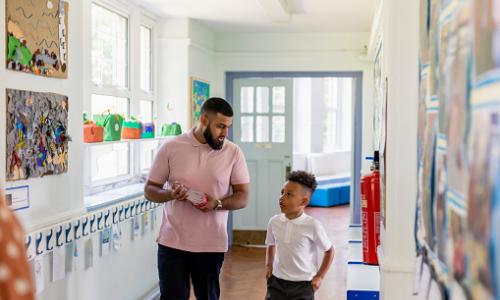Tip #3: Help students correct mispronunciations

Teaching students how to politely correct others when they get their name wrong provides them with a lifelong skill. Learn how to do so from these ideas.
This topic is part of the Learning Students' Names professional learning module from Colorín Colorado.
Learning Objectives
The learning objectives for this topic are:
- Understand the benefits of teaching students how to correct mispronunciations and misspellings of their name
- Learn strategies for teaching students to correct mispronunciations and misspellings of their name
Warm-up
- What are the benefits of teaching students to correct mispronunciations or misspellings of their name?
- How comfortable do you feel correcting others when they make a mistake?
What You Need to Know
You can empower your students by teaching them to politely correct others when they notice a mispronunciation or misspelling of their name. Giving them practice with this kind of activity will increase their confidence to use these skills in the future — skills they may need in setting beyond school and in adulthood.
Tips for Educators
- Ask students to share examples of how people mispronounce their name and how that makes them feel.
- Ask students what the benefits might be learning how to politely correct others.
- Share examples of what students can say to correct mispronunciation, including sample phrases and sentence frames.
- Use role plays with different situations so that students get comfortable using your recommended phrases.
Note: Students may hesitate to correct adults, especially if it is considered disrespectful in their culture. If needed, talk with your colleagues who come from students' cultures to get some ideas for how to approach this topic. You may wish to speak directly with families to hear their concerns and share the goals for the activity.
Related Videos
Read the guiding questions below and watch the related videos.
Guiding question:
- How do Ms. Martinez-Neal and Ms. Dodson see the ability to correct others as a form of advocacy?
Video #1: Our name matters
Award-winning author Juana Martinez-Neal talks about the importance of getting names right.
Video #2: Teaching ELLs to advocate for themselves
ESL teacher Lori Dodson shares examples of how she teaches her young ELLs to advocate for themselves, including correcting mispronunciations of their name.
Reflection/Discussion Questions
These questions can be used in self-reflection, written reflection, or discussion activities.
- What are some different situations in which students might be able to use this skill?
Extension Activities
Extension activities may be used in training, for assignments, or for learning artifacts that can be submitted for credit to professional learning programs.
Sentence Frames
- Think of some sentence frames you could use to help students correct others who mispronounce their names.
Model Lesson
- Develop a lesson plan that teaches students to correct others who misspell or mispronounce their name. Include learning objectives, key vocabulary, related sentence frames, and activities in which students can practice their new skills.
Recommended Resources
To learn more, see our related resource gallery, as well as our easy-to-share resources from Colorín on the Go.
